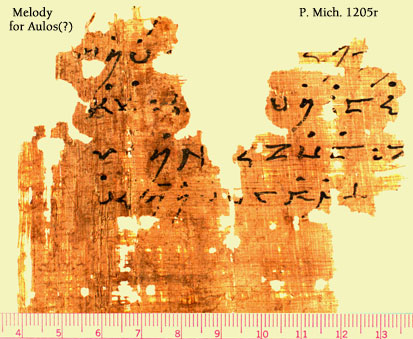
|
Fragments
of Ancient Instrumental
Music: Department of Classical Studies, Duke University |
This Roman era papyrus contains the sort of musical notation used by instrumental musicians in antiquity. The papyrus is a fragment from what was probably a collection of melodies for performance, perhaps intended for the ancient aulos, a woodwind not unlike a modern oboe; or, less likely, the ancient kithara, the performance version of a lyre.
The purpose of this site is to provide an accessible rendition of the music, as a companion to the print publication.Full details in the forthcoming publication: William A. Johnson, "New Instrumental Music from Graeco-Roman Egypt (P. Mich. inv. 1205)," Bulletin of the American Society of Papyrologists 37 (2000) pages 1ff.
CLICK any line in the image below to hear a rendition -- necessarily approximate -- by University of Cincinnati oboist Kimberly Potter. (Or click on "Melody for Aulos" to hear all the fragments in succession.)
[If you do not hear music,click here for help.]

Conventionality of Musical Perceptions, topic 1: A different sort of scale
An example of the earliest type of Greek music, based on tetrachords in the enharmonic genus
(normalized: Kerylos, Annie Belis)
(enharmonic: de Organographia, Gayle and Philip Neuman, WIlliam Gavin)
Conventionality of Musical Perceptions, topic 2: Modulation by tetrachords
The scale for this melody is diatonic, as we expect for music of the Roman era. But the papyrus preserves one of our best examples of a habit apparently characteristic of some ancient composers, modulation by tetrachords, which is one of the reasons that the music sounds somewhat odd to us.In this melody, the ancient composer seems to use not a single scale, nor even to modulate between two scales; rather, the melody seems to move among a series of closely related tetrachords. We'll be able to understand this better by listening to the examples given below.
(Ancient theorists and composers thought not so much in terms of octaves, as in terms of sequences of fourths, which they called "tetrachords". When two tetrachords are conjunct, that is, when the top note of one overlaps with the bottom note of another, two tetrachords combine to form a seventh--whence the famous seven-toned lyre. When two tetrachords are disjunct, that is, when the top note of one is separated by a tone from the bottom note of the next, the two combine to form an octave. The examples below will help make this clear.)
The composition as a whole centers around the central disjunct tetrachords of what an ancient theorist would call the Lydian notation-key:

The central scale
Click to hear the scale, first upwards then downwards
In line 3, however, the composer introduces a modulation. Early in the line, he works down from the central standing note (#43, what the ancients called paramese) in conjunct fashion, that is the scale now becomes:

Modulation, lower conjunct tetrachord
Later in the same line, he returns to the disjunct tetrachord that characterizes the central scale. Compare the two, and listen to the modulation:


Central scale: disjunct tetrachords Modulation: lower conjunct tetrachord
Click to hear the scale, first the central scale (up and down), then the modulation (down)
There is a similar modulation in line 4. There, however, the melody works up, in conjunct fashion from the other central standing note (#40, which the ancients called mesê). Once again, early in the line the scale with the conjunct tetrachords is used, followed by modulation back to the central scale with its disjunct tetrachord. Again, compare the two, and listen to the modulation:


Central scale: disjunct tetrachords Modulation: upper conjunct tetrachord
Click to hear the scale, first the central scale (up and down), then the modulation (up)
Finally, the modulation at the end can also be seen as an easy movement from one of the central tetrachords. In this case, the scale begins at the base of the lower tetrachord, and moves downward, adding a tetrachord in disjunct fashion:


Central scale: disjunct tetrachords Modulation/extension: lower disjunct tetrachord added
Click to hear the scale, first the central scale, then the modulation/extension, both downwards
For full details on the structure of the music, see the print publication.
Link to another musical papyrus, of ancient vocal music.
Link to an introduction and short bibliography on ancient Greek music
Site developed and maintained by William A. Johnson (click to e-mail comments & suggestions)